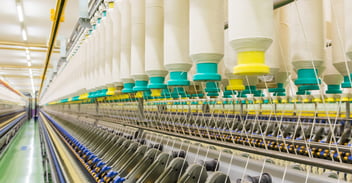

The path from cotton fields to finished yarn is a global ballet of precision—where procurement, quality checks, and inventory management must align seamlessly across continents. With fluctuating cotton quality, stringent standards, and logistical hurdles, even minor disruptions ripple through production. Manual processes strain efficiency, while real-time visibility remains elusive. This is where digital textile ERP steps in—turning fragmented operations into a synchronized, data-driven supply chain that ensures quality, minimizes waste, and keeps production flowing smoothly.
Navigating Challenges in Cotton-to-Yarn Supply Chains
The cotton-to-yarn supply chain is a complex ecosystem where multiple variables must align for smooth operations. However, several persistent challenges make this alignment difficult.

- Price Volatility – Cotton prices fluctuate due to weather conditions, geopolitical factors, and market demand, making cost forecasting and budgeting a constant challenge.
- Inconsistent Quality – Variations in fiber length, strength, and contamination levels affect yarn uniformity, requiring rigorous quality checks and supplier coordination.
- Supplier Reliability – Dependence on global suppliers introduces risks like delayed deliveries, contract breaches, or sudden shortages, disrupting production schedules.
- Asset Allocation & Utilization – Balancing machinery, labor, and energy use efficiently is critical. Underutilization increases costs, while overuse leads to wear and downtime.
- Inventory Management – Maintaining optimal stock levels is tricky. Excess inventory ties up capital, while insufficient supply halts production and delays orders.
- Supply Chain Bottlenecks – Logistics delays, port congestion, or transportation breakdowns can ripple through the entire chain, affecting lead times and customer commitments.
Addressing these challenges requires robust planning, real-time data analytics, strong supplier relationships, and contingency strategies. While the road is not easy, a robust textile ERP solution can help mitigate risks and ensure a resilient supply chain.
The Role of Textile ERP in Strengthening Cotton-to-Yarn Businesses
Running a cotton-to-yarn business involves juggling multiple processes—procurement, quality control, production, and asset management—all while maintaining efficiency and profitability. This is where ERP systems become indispensable.
An ERP integrates core business functions into a unified platform, providing real-time visibility and control. For cotton-to-yarn manufacturers, this means:
- Streamlined Cotton Procurement: Tracking orders, supplier performance, and pricing trends to optimize purchasing decisions.
- Automated Quality Checks: Ensuring consistent fiber quality through digitized inspections and compliance tracking.
- Efficient Production Planning: Synchronizing ginning, spinning, and yarn production to minimize downtime and waste.
- Improved Asset Utilization: Monitoring machinery performance and maintenance schedules to maximize productivity.
Digitalizing the Cotton-to-Yarn Process with Textile ERP: Benefits
The journey from cotton bales to high-quality yarn is a complex, multi-stage process where precision and coordination are critical. Any disruption—whether in procurement, quality checks, or spinning—can halt production, leading to costly delays and rework. Digitalizing this process with a textile ERP system ensures seamless operations, real-time monitoring, and data-driven decision-making, minimizing risks and maximizing efficiency.
Real-Time Data & Automated Quality Control
ERP systems digitize every step, from procurement to yarn conversion. When cotton bales arrive, real-time data capture records weight, moisture content, and fiber quality, ensuring only compliant materials proceed. Automated quality checks eliminate human error, flagging deviations before they disrupt production. For instance, excess moisture can weaken fibers, while inconsistent weight affects yarn uniformity—textile ERP prevents such issues by enforcing strict quality thresholds.
Digital Payments & Transparent Procurement
Procurement becomes faster and more transparent with ERP. Payments are automatically processed based on accepted quantities, reducing disputes and delays. Suppliers receive instant updates, fostering trust and long-term partnerships.
Interlinked Processes: Preventing Costly Disruptions
The cotton-to-yarn workflow involves:
- Ginning (separating fibers from seeds)
- Blending (mixing fibers for consistency)
- Carding & Drawing (aligning fibers into slivers)
- Spinning (twisting fibers into yarn)
If a defective bale slips through or a machine malfunctions, the entire line may stop, forcing reprocessing. Textile ERP tracks each batch digitally, ensuring traceability and quick issue resolution. For example, if a moisture imbalance is detected in spinning, the system traces it back to the source, preventing further waste.
Reducing Costs & Enhancing Productivity
By digitizing workflows, ERP minimizes manual intervention, reduces downtime, and optimizes inventory. By automating quality checks, they reduce material waste and rework costs. Maintaining the right cotton inventory while meeting yarn demand is a delicate balance. Textile ERP transforms this challenge by tracking stock in real time, forecasting demand accurately, and optimizing production schedules. Real-time inventory tracking prevents overstocking and shortages, optimizing working capital. Production scheduling becomes precise, minimizing machine downtime and energy waste. Digital procurement ensures fair cotton pricing, while automated payments accelerate cash flow. In short, data-driven insights enable mills to achieve higher output with fewer resources.
Transforming Efficiency with Ramco ERP: A Success Story
A leading South Indian yarn manufacturer partnered with us to streamline their operations using ERP. The results were remarkable: 5% higher asset utilization and productivity, and significant improvement in quality deviation through timely alerts. By digitizing workflows, they gained precision in monitoring and faster response times—proving that smart technology drives tangible growth. Their success showcases how Ramco ERP turns operational challenges into measurable gains.
Embrace Textile ERP for a Future-Ready Textile Supply Chain
The cotton-to-yarn journey demands precision, agility, and end-to-end visibility—all of which modern ERP systems deliver. From automating quality checks and optimizing inventory to preventing costly disruptions, textile ERP empowers textile manufacturers to transform supply chain challenges into competitive advantages. The proven results—higher productivity, fewer errors, and stronger supplier relationships—speak for themselves. In an industry where margins are tight and efficiency is everything, adopting ERP isn’t just an upgrade; it’s a strategic necessity.
Ready to future-proof your operations? The time to digitize is now. Explore how Ramco ERP can streamline your cotton-to-yarn business—connect with us today.
Frequently Asked Questions (FAQs)
Enterprise asset management (EAM) involves the management of mission critical assets of an organization throughout each asset's lifecycle. EAM is used to plan, optimize, execute, and track the needed maintenance activities with the associated priorities, skills, materials, tools, and information. The aim is to optimize the quality and utilization of assets throughout their lifecycle, increase productive uptime and reduce operational costs.
Enterprise asset management (EAM) involves the management of the maintenance of physical assets of an organization throughout each asset's lifecycle. EAM is used to plan, optimize, execute, and track the needed maintenance activities with the associated priorities, skills, materials, tools, and information.
The software helps in effective maintenance of assets through preventive, predictive, shutdown and breakdown maintenance strategies. The system also helps enterprises mitigate equipment risks by enhanced safety standards. The streamlined operations and improved asset performance helps organizations increase their investment effectiveness.
EAM is important because it helps organizations track, assess, manage and optimize asset quality and reliability. Asset intensive Organizations have hundreds, thousands, even millions of assets which needs to be maintained to maximize / optimize life of these assets to increase the return on investment.
The key features of effective EAM are:
- Work management.
- Maintenance Strategies (Preventive/ Predictive / Breakdown / Shutdown).
- Planning and scheduling.
- Supply chain management.
- Health and safety.
- Mobility.
- Analytics.
- Improved Asset Health at reduced cost through data driven maintenance Programs
- Complete visibilityon entire maintenance data across Equipment, across Models, across Branches to aid in analysis & decision making such as to Repair or Replace the Equipment
- Insightful analysis of Inspection Data to improve customer satisfaction
- Effective maintenance management enhanced by predictive maintenance and inbuilt analytics
- Increased reliability and safety, keeps complete track of all the inspections & calibration schedules
- Mobile Application enables users to execute work while “in the field” leading to minimized non-productive time and increased productivity and reduces duplication of work and human errors in recording information.
- Quick turnaround time through Actionable Notification & Alerts for every process in real time and accessible anytime and anywhere.
- Improved Regulatory Part of asset management involves the implementation of better O&M practices, which can significantly improve compliance.
Asset Intensive companies under the following Industries :
- Ports
- Cement and Mining
- Utilities
- Fleet Maintenance
- Equipment Rental
- Other Manufacturing
- Real Estate & Infrastructure
- Power Generation
Contact us for a meeting and schedule a demo
This differs on case to case basis, based on the type of installation and unique industry specific requirements. Contact us for a meeting and schedule a demo.
This differs on case to case basis, based on the type of installation and unique industry specific requirements. Contact us for a meeting and schedule a demo.
Stay Connected, follow us on LinkedIn / Twitter to know more about EAM Software latest trends.


